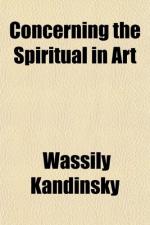The artist must be blind to distinctions between “recognized” or “unrecognized” conventions of form, deaf to the transitory teaching and demands of his particular age. He must watch only the trend of the inner need, and hearken to its words alone. Then he will with safety employ means both sanctioned and forbidden by his contemporaries. All means are sacred which are called for by the inner need. All means are sinful which obscure that inner need.
It is impossible to theorize about this ideal of art. In real art theory does not precede practice, but follows her. Everything is, at first, a matter of feeling. Any theoretical scheme will be lacking in the essential of creation—the inner desire for expression—which cannot be determined. Neither the quality of the inner need, nor its subjective form, can be measured nor weighed.
[Footnote: The many-sided genius of Leonardo devised a system of little spoons with which different colours were to be used, thus creating a kind of mechanical harmony. One of his pupils, after trying in vain to use this system, in despair asked one of his colleagues how the master himself used the invention. The colleague replied: “The master never uses it at all.” (Mereschowski, Leonardo DA Vinci).]
Such a grammar of painting can only be temporarily guessed at, and should it ever be achieved, it will be not so much according to physical rules (which have so often been tried and which today the Cubists are trying) as according to the rules of the inner need, which are of the soul.
The inner need is the basic alike of small and great problems in painting. We are seeking today for the road which is to lead us away from the outer to the inner basis.
[Footnote: The term “outer,” here used, must not be confused with the term “material” used previously. I am using the former to mean “outer need,” which never goes beyond conventional limits, nor produces other than conventional beauty. The “inner need” knows no such limits, and often produces results conventionally considered “ugly.” But “ugly” itself is a conventional term, and only means “spiritually unsympathetic,” being applied to some expression of an inner need, either outgrown or not yet attained. But everything which adequately expresses the inner need is beautiful.]
The spirit, like the body, can be strengthened and developed by frequent exercise. Just as the body, if neglected, grows weaker and finally impotent, so the spirit perishes if untended. And for this reason it is necessary for the artist to know the starting point for the exercise of his spirit.
The starting point is the study of colour and its effects on men.
There is no need to engage in the finer shades of complicated colour, but rather at first to consider only the direct use of simple colours.
To begin with, let us test the working on ourselves of individual colours, and so make a simple chart, which will facilitate the consideration of the whole question.




